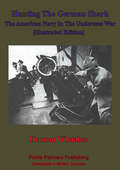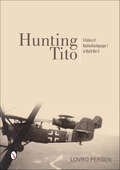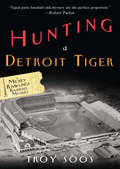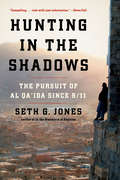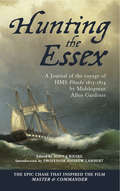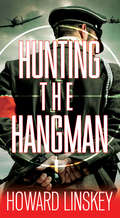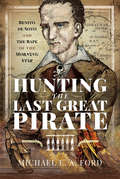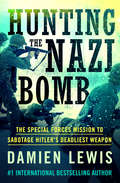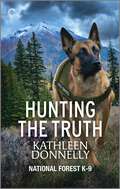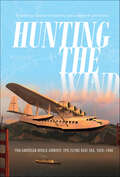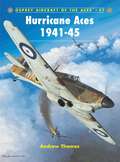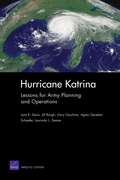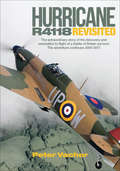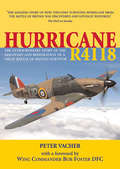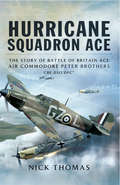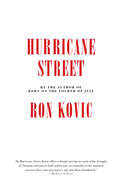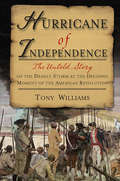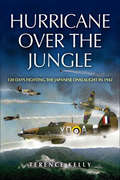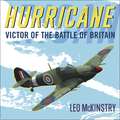- Table View
- List View
Hunting The German Shark; The American Navy In The Underseas War [Illustrated Edition]
by Herman Whitaker"The 'shark killers' of the U. S. fleet""The United States of America entered the First World War in April 1917, though its support for the allied war effort had, of course, been immensely influential in terms of the provision of material up to that point. The direct intervention of America in the war, with its vast resources of military personnel and equipment, backed by a huge manufacturing capacity, was inevitably pivotal. This account, part history, part anecdotal and part first hand account, was written shortly before the end of the conflict and describes in some detail the endeavours of the United States Navy during the war at sea in general and, more particularly, how it dealt with the omnipresent menace of the, 'German Shark'--the U Boats of the German Navy. This hidden undersea threat bore directly on America's role in the war. Men and vitally needed supplies had to traverse the Atlantic in merchant vessels to reach Europe. They were perilously exposed to the depredations of the German submarine force whose task it was to prevent them reaching their destinations. This well written and engaging book takes the reader to war on the United States Navy destroyers and with the navy pilots of early military aircraft whose task it was to pursue and destroy U-Boats in order to protect the vulnerable convoys of merchantmen on the high seas. Many interesting engagements, duels and sinkings are described in compelling detail from first-hand experience. An essential book for all those particularly interested in submarine and anti-submarine warfare or the Great War generally."-Leonaur Print VersionAuthor -- Whitaker, Herman, 1867-1919.Text taken, whole and complete, from the edition published in New York, The Century co., 1918.Original Page Count - 310 pagesIllustrations -- 15 illustrations.
Hunting The Nazi Bomb: The Secret Mission to Sabotage Hitler's Deadliest Weapon
by Damien Lewis'You couldn't make these stories up: yet they're true, and Lewis does the memory of these extraordinary men full justice in a tale that is both heart-stopping and moving' Evening Standard'Suicidal bravery, untold moral courage and awe-inspiring survival. An utterly compelling read' Bear GryllsFrom the bestselling author of true military classics ZERO SIX BRAVO, THE NAZI HUNTERS and CHURCHILL'S SECRET WARRIORSIn the Spring of 1940, as Britain reeled from defeats on all fronts and America seemed frozen in isolation, one fear united the British and American leaders like no other: the Nazis had stolen a march on the Allies towards building the atomic bomb. So began the hunt for Hitler's nuclear weapons - nothing else came close in terms of priorities. It was to be the most secret war of those wars fought amongst the shadows. The highest stakes. The greatest odds.Prior to the outbreak of the war the massive German chemicals conglomerate I.G. Farben - the future manufacturers of Zyklon-B, the gas used in the Nazi concentration camps - had started producing bulk supplies of deuterium oxide - heavy water - at the remote Norwegian plant of Vemork. This was the central target of three separate missions - Operations GROUSE, FRESHMAN and GUNNERSIDE - over the ensuing four years. As Churchill commented: 'The actual facts in many cases were equal to the most fantastic inventions of romance and melodrama. Tangle with tangle, plot and counter-plot, ruse and treachery, cross and double-cross, true agent, false agent, double agent, gold and steel, the bomb, the dagger and the firing party were interwoven in a texture so intricate as to be incredible yet true.'Damien Lewis's new bestseller intercuts the hunt for the scientists, the raw materials and the plant, with the cloak and dagger intelligence game being played in the shadows. This relied in part on ENIGMA intercepts to guide the SOE's hand. Lewis delves into some of the most extraordinarily inventive and Machiavellian innovations at the SOE, and their related research and training schools, whereby the enemy were tricked, deceived, framed, blackmailed and double and triple-crossed, all in the name of stopping the Reich from getting the bomb.Previously published as Hunting Hitler's Nukes
Hunting Tito: A History of Nachtschlachtgruppe 7 in World War II
by Lovro PeršenFor the first time, the history of one of the most significant and longest-lasting Luftwaffe combat units is presented. Operating against Tito and his partisans in Yugoslavia, Nachtschlachtgruppe 7, and its predecessor units Störkampfstaffel Kroatien and Südost, fought an extraordinary war--one that was different from any other Nachtschlachtgruppe in existence on either the eastern or western fronts. The history of Nachtschlachtgruppe 7 is unbreakably cross-linked with its "sister" unit Nahaufklärungsstaffel Kroatien, who eventually became its 2.Staffel in Autumn 1943. Despite their obsolete equipment--flying the Hs 126, Do 17 and He 46--they fought courageously against Tito's forces until the end of the war.
Hunting a Detroit Tiger: A Mickey Rawlings Baseball Mystery (A Mickey Rawlings Mystery #4)
by Troy SoosIn 1920 Detroit, a ballplayer is called out for the murder of a union organizer and must find the real killer: &“Taut with plot twists.&”—Publishers Weekly It's 1920, and perennial 25th man Mickey Rawlings has found a spot on the Detroit roster with a .250 average and 20 stolen bases. Respectable numbers for a utility infielder. Unfortunately that doesn't exempt him from being put in a lineup for murder, even if he's playing toss with the tempestuous talents of Ty Cobb. Mickey admits he was at a player's union rally in Fraternity Hall, but he insists he had nothing to do with the bullet that shot organizer Emmett Siever. It turns out convincing his teammates and the front office of his innocence is about as easy as selling a slide into second to a blind ump. Before Mickey's journeyman career takes one last wrong turn—into a grave—he needs to find the real killer to keep the ball in play and maybe contribute to the Tigers&’ climbing out of last place in the standings… &“Mickey's fourth outing may be his best nine innings.&”—Kirkus Reviews &“Equal parts baseball and mystery are the perfect proportion.&”—Robert B. ParkerPraise for the Mickey Rawlings Baseball Mysteries &“Full of life.&”—The New York Times Book Review &“A perfect book for the rain delay…a winner.&”—USA Today &“Delightful…period detail that will leave readers eager for subsequent innings.&”—Publishers Weekly
Hunting and Trapping on the Upper Magalloway River and Parmachenee Lake: First Winter in the Maine Wilderness
by Capt Fred C Barker J S DanforthThis vivid memoir, Hunting and Trapping on the Upper Magalloway River and Parmachenee Lake: First Winter in the Maine Wilderness, by Walter M. Barker and Gerrit S. Danforth, transports readers to the rugged, untamed wilderness of northern Maine in the late 19th century. The book chronicles the authors' adventurous first winter deep in the forest, capturing their experiences as they navigate the challenges of living off the land in one of the most remote regions of New England.Through detailed accounts, Barker and Danforth describe the thrill of tracking game, the art of setting traps, and the constant struggle to survive against unforgiving elements. Their encounters with moose, deer, and other wildlife provide insights into the region's ecosystem, while their interactions with local woodsmen and trappers add authenticity and warmth to the narrative.More than just a hunting and trapping guide, the book offers readers a window into the mindset and lifestyle of those who embraced isolation and adventure in pursuit of self-sufficiency and exploration. It celebrates the beauty and harshness of the Maine wilderness, revealing the joy and hardship found in a life close to nature.This work captures not only the spirit of early outdoor adventure but also a vanishing way of life, making it a timeless read for anyone interested in wilderness survival, hunting lore, and the history of Maine’s frontier.
Hunting in the Shadows: The Pursuit of al Qa'ida since 9/11
by Seth G. JonesFrom one of our most trusted counterterrorism experts, a sweeping, insider's account of the decade-long chase for America's deadliest enemy. This landmark history chronicles the dramatic, decade-long war against al Qa'ida and provides a model for understanding the ebb and flow of terrorist activity. Tracing intricately orchestrated terrorist plots and the elaborate, multiyear investigations to disrupt them, Seth G. Jones identifies three distinct "waves" of al Qa'ida violence. As Jonathan Mahler wrote in the New York Times Book Review, "studying these waves and the counterwaves that repelled them can tell us a lot about what works and what doesn't when it comes to fighting terrorism." The result is a sweeping, insider's account of what the war has been and what it might become.
Hunting the Eagles (Eagles of Rome #2)
by Ben KaneFrom 'the rising star of historical fiction' (Wilbur Smith) a new Eagles of Rome novel, by the Sunday Times bestselling author of Eagles at War.JUSTICE , HONOUR, REVENGE AD 14: Five long years have passed since the annihilation of three legions in the wilds of Germania. Demoted, battle-scarred and hell-bent on revenge, Centurion Tullus and his legionaries begin their fightback. Ranged against them is the charismatic chieftan Arminius, determined to crush the Romans for a second time. Convinced that the eagle belonging to his old legion is close at hand, Tullus drives ever deeper into enemy lands. But with Arminius and his warriors closing in on the Romans, a murderous battle is about to begin…
Hunting the Essex: A Journal of the Voyage of HMS Phoebe, 1813–1814
by Midshipman Allen GardinerIn February 1813 the British frigate Phoebe set out on a secret mission that would involve sailing halfway around the world to attack American settlements in the Pacific Northwest. The United States, frustrated at the treatment of its shipping by the combatants in the Napoleonic Wars, had finally opened hostilities against the British in the previous June. From the American perspective the War of 1812 began with disasters in its invasion of Canada, but against all expectations the infant US Navy had scored significant victories at sea. The most strategically significant of these was the campaign by the frigate USS Essex, which had almost annihilated the lucrative British whaling trade in the south Pacific. Therefore, Phoebe was diverted to hunt down and destroy this highly successful commerce-raider. After an epic search, Phoebe tracked her prey to neutral Valparaiso where the American frigate was blockaded and,in a very bloody battle, eventually captured. The American captain, David Porter, published a self-serving account of his actions which ever since has mired the battle in controversy, so this British naval eyewitness account is an important counter-balance. It is one of the lesser-known campaigns of a war which is currently celebrating its bicentenary, but its inherent drama inspired the plot of Patrick O'Brian's novel The Far Side of the World, although in its movie adaptation Master & Commander the American frigate is transformed into a French privateer.
Hunting the Hangman
by Howard LinskeyWhat an entire army couldn&’t do, two men must: take out the Butcher of Prague.Operation Anthropoid has been engaged. 1941. The Third Reich is at its zenith. Its protector is Reinhard Heydrich, the most merciless senior figure in Hitler&’s inner circle, and the Fuhrer&’s eventual successor. Under Heydrich&’s oppressive command, thousands of lives have already been erased in Czechoslovakia&’s capital. It&’s only Heydrich&’s first ruthless step in service to the German people. Heydrich&’s ultimate endgame is the Final Solution. But under the cloak of night, the resistance conspires as well. Trained in subterfuge by the British Special Operations, Josef Gabcik and Jan Kubis are unfailingly dedicated soldiers. Now, as committed allied agents they&’ve been tasked with an audacious and seemingly impossible mission: parachute into an occupied city in lockdown, rally the remaining Czech rebels, and assassinate one of the most dangerous men alive. Outmanned against insurmountable odds, Gabcik and Kubis have no choice but to succeed. The fate of Europe and the world is in their hands. High Acclaim for Ungentlemanly Warfare &“A stellar novel of high-octane action, adventure and suspense.&”—Steve Berry, New York Times bestselling author &“Reads like the new The Day of the Jackal—swift, deadly, game over!&”—John Ellsworth, USA Today bestselling author of The Point of Light &“A heart-pounding thriller from cover to cover. I couldn&’t put it down.&”—James D. Shipman, author of Task Force Baum &“A perfect companion for fans of the great Ken Follett.&”—Chuck Driskell, author of Final Mission: Zion
Hunting the Last Great Pirate: Benito de Soto and the Rape of the Morning Star
by Michael Edward FordA true, century-spanning saga of terror at sea, a dramatic trial, and a mystery at long last solved . . .In 1827 the Duke of Wellington—former Commander-in-Chief of the British Army and British Prime Minister—ordered the withdrawal of British soldiers from the island of Ceylon after years of bloody conflict there. English cargo vessels, including the unarmed English Quaker ship Morning Star, were dispatched to sail to Colombo to repatriate wounded British soldiers and a cargo of sealed crates containing captured treasure. By January 1828, Morning Star was anchored at Table Bay, Cape Town, before joining an armed British convoy of East Indiamen heading north. Heavily laden, she struggled to keep up with the ships ahead. But a heavily armed pirate ship and its master, the notorious Benito de Soto, were lying in wait off Ascension Island in the mid-Atlantic to pick off stragglers from passing convoys. This book tells the full story of how Morning Star was easily overhauled by the pirate and stopped with cannon fire, the bloody events that followed, the long quest to hold de Soto to account—and the remarkable discovery that was made nearly a century later.
Hunting the Nazi Bomb: The Special Forces Mission to Sabotage Hitler's Deadliest Weapon
by Damien LewisA &“gripping&” and &“heart-stopping&” account of the combined Norwegian and British sabotage raids to stop Hitler from making an atomic bomb (Saul David, Evening Standard). Nothing terrified the Allies more than Adolf Hitler&’s capacity to build a nuclear weapon. In a heavy water production plant in occupied Norway, the Führer was well on his way to possessing the raw materials to manufacture the bomb. British Special Operations Executive (SOE)—Churchill&’s infamous &“Ministry of Ungentlemanly Warfare&”—working with the Norwegian resistance executed a series of raids in the winter of 1942–43, dropping saboteurs to destroy Hitler&’s potential nuclear capability: operations Musketoon, Grouse, Freshman, and finally Gunnerside, in which a handful of intrepid Norwegians scaled a 600-foot cliff to blow the heavy water plant to smithereens. Nothing less than the security of the free world depended on their success. The basis for the movie, The Heroes of Telemark, starring Kirk Douglas and Richard Harris, this true story is more harrowing than any thriller, and &“Lewis does the memory of these extraordinary men full justice in a tale that is both heart-stopping and moving&” (Saul David, Evening Standard).
Hunting the Truth (National Forest K-9 #2)
by Kathleen Donnelly&“Hide, Maya. Don&’t let the bad people find you.&”Those are the last words Forest Service law enforcement officer and K-9 handler Maya Thompson ever heard her mother say.Returning to the Colorado mountains, ex-soldier Maya is no longer a scared little girl. She&’s here to investigate her mother&’s cold case, but fear creeps in when it comes to her personal life—things are getting serious with sheriff deputy Josh Colten.After new DNA evidence surfaces, both her beloved grandfather and Josh warn her away from the case, suspecting that she could be the next victim. But Maya doesn&’t listen.Instead, Maya and her K-9 partner, Juniper, track a suspect deep into the forest and directly into grave danger…National Forest K-9Book 1: Chasing JusticeBook 2: Hunting the Truth
Hunting the Wind: Pan American World Airways' Epic Flying Boat Era, 1929–1946
by Teresa Webber Jamie DodsonTake your seats, and by all means, fasten your seat belts! Come on a journey back in time to aviation’s most daring and innovative era. Travel back nine decades, when for the first time, airplanes determined the victors of global wars—a time that altered the course of the world. Hear never-before-told true stories penned by still-living flight crew members and passengers. Learn about the remarkable men, women, and aircraft builders who launched an aviation phenomenon. Thrill to the romance, adventure, and danger air travelers encountered flying to far-flung, exotic lands. Marvel at art deco air terminals, the world’s only flying-boat museum, and onboard luxuries rivaling five-star hotels. Like mythical Camelot, it was a brief, shining moment. But this was no myth. It was an extraordinary point in global history when Pan American’s quintessentially magnificent flying boats ruled the skies.
Hurricane Aces 1941-45
by John Weal Andrew ThomasThe Hurricane saw widespread action with Allied forces, as the RAF's first monoplane fighter. This book describes its many feats throughout 1945. It served as a fighter-bomber on the Channel Front, where the American Eagles and Polish units were amongst the Fighter Command squadrons flying the Hurricane, and where some of its highest-scoring aces operated. The Sea Hurricane was the principal fighter deployed by the Fleet Air Arm in the Mediterranean, and Hurricane units continued to operate from bases in India and Ceylon until 1945, following their failure to defend Singapore and Malaya from the Japanese.
Hurricane Katrina: Lessons for Army Planning and Operations
by Lynn E. Davis Agnes Gereben Schaefer Gary Cecchine Laurinda L. Zeman Jill Rough Laurinda L. RohnThe efforts undertaken by civilian and military organizations in response to Hurricane Katrina were historically unprecedented, but a number of changes would enhance future Army and National Guard disaster-response efforts, including preparing governors to call up Guard units for out-of-state emergencies and the creation of regional standing homeland security task forces.
Hurricane R4118 Revisited: The Extraordinary Story of the Discovery and Restoration to Flight of a Battle of Britain Survivor: The Adventure Continues 2005–2017
by Peter Vacher&“Peter Vacher has revised and updated his classic account of the discovery and restoration of our Hawker Hurricane Mk I-R4118.&” —Hurricane Heritage Twelve years since the amazing account of Peter Vacher&’s discovery in India was originally published, Grub Street is thrilled to bring readers the updated story of Hurricane R4118. Since the restoration of this magnificent aircraft to flight in 2004, Peter Vacher continued to research its history. In Hurricane R4118 Revisited, more stories of R4118&’s origins are told, including the extraordinary tale of how this aircraft shot down a friendly Whitley bomber before it was assigned to a RAF squadron. Focus is also given to the role of 605 Squadron&’s ground crew and the aircraft during the Battle of Britain. Continuing into the present day, Vacher highlights the challenges of maintaining and flying a historic warbird, while Keith Dennison, a warbird pilot, provides expert commentary on exactly what it is like to fly a Hurricane. The book concludes with the sale of R4118 to an enthusiastic Englishman and the decision taken to keep the aircraft at the Shuttleworth Collection. With brand new photography and sources, including wartime letters from veteran pilot Bunny Currant, this book is essential reading for all Hurricane enthusiasts.&“Photos and firsthand accounts trace the ongoing restoration and display of a legendary aircraft.&” —FineScale Modeler
Hurricane R4118: The Extraordinary Story of the Discovery and Restoration of a Great Battle of Britain Survivor
by Peter Vacher Bob FosterA fascinating account of the only airworthy Hawker Hurricane, &“now regarded as the most historic British aircraft to survive in flying condition from WW2&” (FLYER). In 1982 when he was traveling in India, Peter Vacher stumbled on the remains of a British plane—a Hurricane Mark I, a veteran of the Battle of Britain. It was in a dreadful state. Could he restore it? Would it fly again? Not until 14 years later did he decide to act and after six years of wrangling he got the icon home. Then the truly difficult process of restoration began—a worldwide search for parts, careful reconstruction, flight testing—-until in 2005 it flew again to the delight of thousands of enthusiasts. Along the way Peter reunited three auspicious veterans—Peter Thompson, Bunny Currant, and Bob Foster—with R4118, men who had flown her during the war. To this day, the aircraft&’s grace and splendor in flight is enjoyed by crowds across the UK.&“The amazing story of how this only surviving Hurricane from the Battle of Britain was discovered and lovingly restored.&” —The Mail on Sunday
Hurricane Squadron Ace: The Story of Battle of Britain Ace, Air Commodore Peter Brothers, CBE, DSO, DFC and Bar
by Nick Thomas“The story of one of the most heroic fighter aces of the Second World War . . . has been brought to life in this gripping new book.” —Lancashire Living MagazineAir Commodore Peter Malam “Pete” Brothers CBE, DSO, DFC, and Bar (1917-2008) was one of the most highly praised pilots of the Second World War. Decorated extensively, he secured a total of 16 “kills” over the course of the conflict, with 10 of these occurring during the Battle of Britain. Pivotal moments in his career include the time, in August 1940, when his flight encountered around a hundred enemy aircraft, including Messerschmitt 110s; he led the flight in attack against them, and soon found himself in a stalled position, out of which he spun, only to be confronted by a Dornier 215, which he shot down, before later destroying a Messerschmitt 109. Scores of these kind of risky maneuvers and winning victories punctuated a career defined by great courage, leadership and initiative in the face of fierce opposition. This new and engaging biography profiles a pilot who, until now, hasn’t been the subject of such a thorough book-length study. The story of his career is incredibly entertaining, featuring a number of hair-raising episodes, and is sure to appeal to fans of aviation history as well as the more general reader seeking out an action-packed biography offering fresh insights into one of the most pivotal conflicts of the twentieth century.“An engaging story of one of The Few . . . This is a book that entertains, inspires, moves, amuses, surprises—what more could any reader ask for.” —FIRE Project
Hurricane Street
by Ron Kovic"Hurricane Street...[is] another raw expose on the cost of war. The book, which he calls a prequel, drills deep into the 17-day drama of a 1974 sit-in and hunger strike staged by Kovic and a band of fellow wounded veterans who took the federal building on Wilshire Boulevard by storm...The book is an unflinching anti-war declaration, written in blood and the sweat of too many haunted nights by a Vietnam Marine Corps sergeant who later opposed the wars in Iraq and Afghanistan."--Los Angeles Times"The author of Born on the Fourth of July (1976) recounts the brief 1974 movement he initiated to change how Veterans Affairs hospitals cared for wounded soldiers...The great strength of this book is that the author never minces words. With devastating candor, he memorializes a short-lived but important movement and the men who made it happen. Sobering reflections on past treatment of America's injured war veterans."--Kirkus Reviews"[A] compelling snapshot of early 1980s activism....Without social media or cell phones to boost the signal, it was Kovic's flair for the dramatic and ability to marshal reporters that turned the protest into a battle victory....Kovic's updates on the fates of his fellow veterans provide a memorable and bittersweet conclusion."--Publishers Weekly"The author of the bestseller Born on the Fourth of July writes an impassioned and timely memoir about the 1974 American Veterans Movement that will strike a chord with veterans and their families today."--Publishers Weekly, Top 10 Pick for Spring 2016"Kovic, a Vietnam veteran paralyzed from the waist down and the author of the seminal war memoir Born on the Fourth of July (1976), looks back to the spring of 1974, when he led a two-week hunger strike in the Los Angeles office of U.S. Senator Alan Cranston . . . Kovic's personal tale is also a timely topical book as veterans' mental and physical health care remain woefully insufficient."--Booklist"Kovic has also penned a new book, Hurricane Street, that will be released on July 4th. The new book recounts how in 1974, the author and other injured veterans staged a sit-in and hunger strike to demand better treatment for vets."--Rolling Stone"Renowned antiwar activist Kovic, a Vietnam veteran, delivers a powerful memoir detailing his organization of the American Veterans Movement (AVM) during the mid-1970s . . . This chronicle will resonate with those interested in the all-too-human effects of war and the challenges faced by our wounded warriors."-- Library Journal"Forty years after the release of Born on the Fourth of July, the 1976 memoir that became the 1989 Academy Award-winning film starring Tom Cruise, author Ron Kovic gives us Hurricane Street, a memoir about his 1974 movement to change the way Veterans Affairs hospitals cared for wounded soldiers."--ParadeIn the spring of 1974, as the last American troops were being pulled out of Vietnam, Ron Kovic and a small group of other severely injured veterans in a California VA hospital launched the American Veterans Movement. In a phenomenal feat of political organizing, Kovic corralled his fellow AVM members into staging a sit-in, and then a hunger strike, in the Los Angeles office of Senator Alan Cranston, demanding better treatment of injured and disabled veterans.This was a short-lived and chaotic but ultimately successful movement to improve the deplorable conditions in VA hospitals across the country. Hurricane Street is their story--one that resonates deeply today--told
Hurricane of Independence: The Untold Story of the Deadly Storm at the Deciding Moment of the American Revolution
by Tony WilliamsThe sleeper history hit of 2008, released in paperback to coincide with the heart of hurricane season. On September 2, 1775, the eighth deadliest Atlantic hurricane of all time landed on American shores. Over the next days, it would race up the East Coast, striking all of the important colonial capitols and killing more than four thousand people. In an era when hurricanes were viewed as omens from God, what this storm signified to the colonists about the justness of their cause would yield unexpected results. Drawing on ordinary individuals and well-known founders like Washington and Franklin, Tony Williams paints a stunning picture of life at the dawn of the American Revolution, and of the weighty choice people faced at that deciding moment. Hurricane of Independence brings to life an incredible time when the forces of nature and the forces of history joined together to produce courageous stories of sacrifice, strength, and survival.
Hurricane over the Jungle: 120 Days Fighting the Japanese Onslaught in 1942
by Terence KellyThe author and WWII fighter pilot offers a firsthand look at an RAF squadron&’s harrowing fate in this candid combat memoir. Before he became a prolific author of history and fiction, Terence Kelly served in the Royal Air Force during World War II, flying Hawker Hurricanes in combat against the Japanese. Hurricanes Over the Jungle is Kelly&’s personal account of what happened to the twenty-two pilots of No. 258 Squadron, RAF, after leaving Scotland in late October 1941. One hundred and twenty days later, all those who had not been killed became prisoners of the Japanese. This heartbreaking story takes readers to the final defense of Singapore and then on to Sumatra and Java. In his vivid narrative, Kelly recaptures the atmosphere of squadron life, the bitter aerial engagements with the Japanese enemy, and the hostile jungle terrain over which they fought. For its honest depiction of front line combat, and its criticism of British and Allied failures that resulted in lost lives, Hurricane Over the Jungle offers an important perspective on the Pacific Theater of World War II.
Hurricane: The Plane That Saved Britain
by Adrian StewartThe riveting exploits of a fighter aircraft – and an underrated aerial hero of the Second World WarThe Hawker Hurricane was flying on the outbreak of war in 1939. Six years later, having saved Britain, it was still playing a major part in the war effort.Widely remembered in its fighter role and unjustly left in the shade of the Spitfire, the Hurricane’s role was varied and pivotal: as a fighter, fighter-bomber, anti-tank aircraft and used at sea. Nor was its theatre of operations any less wide: it saw action in France from the beginning of the Phoney War to the outbreak of the Blitzkrieg, in the Battle of Britain, and then as far afield as Russia, Sumatra and Madagascar.In this intensely readable, spirited and classic account, Adrian Stewart describes all the Hurricane’s roles, adventures and achievements. He recounts the exploits of the aircraft’s outstanding pilots who contributed so much towards mastery of the skies and eventual victory.Perfect for readers of John Nichol’s Spitfire and Lancaster.
Hurricane: Victor of the Battle of Britain
by Leo McKinstryIn the summer of 1940 the fate of Europe hung in the balance. Victory in the forthcoming air battle would mean national survival; defeat would establish German tyranny.The Luftwaffe greatly outnumbered the RAF, but during the Battle of Britain it was the RAF that emerged triumphant, thanks to two key fighter planes, the Spitfire and the Hurricane. The Hurricane made up over half of Fighter Command's front-line strength, and its revolutionary design transformed the RAF's capabilities.Leo McKinstry tells the story of the remarkable plane from its designers to the first-hand testimonies of those brave pilots who flew it; he takes in the full military and political background but always keeps the human stories to the fore - to restore the Hawker Hurricane to its rightful place in history.
Hurricane: Victor of the Battle of Britain
by Leo McKinstryIn the summer of 1940 the fate of Europe hung in the balance. Victory in the forthcoming air battle would mean national survival; defeat would establish German tyranny.The Luftwaffe greatly outnumbered the RAF, but during the Battle of Britain it was the RAF that emerged triumphant, thanks to two key fighter planes, the Spitfire and the Hurricane. The Hurricane made up over half of Fighter Command's front-line strength, and its revolutionary design transformed the RAF's capabilities.Leo McKinstry tells the story of the remarkable plane from its designers to the first-hand testimonies of those brave pilots who flew it; he takes in the full military and political background but always keeps the human stories to the fore - to restore the Hawker Hurricane to its rightful place in history.
Hurricane: Victor of the Battle of Britain
by Leo McKinstryThe biography of the aeroplane that won the Battle of Britain.In the summer of 1940 the fate of Europe hung in the balance. Victory in the forthcoming air battle would mean national survival; defeat would establish German tyranny.The Luftwaffe greatly outnumbered the RAF, but during the Battle of Britain it was the RAF that emerged triumphant, thanks to two key fighter planes, the Spitfire and the Hurricane. The Hurricane made up over half of Fighter Command's front-line strength, and its revolutionary design transformed the RAF's capabilities. Leo McKinstry tells the story of the remarkable plane from its designers to the first-hand testimonies of those brave pilots who flew it; he takes in the full military and political background but always keeps the human stories to the fore - to restore the Hawker Hurricane to its rightful place in history.(P)2018 Hodder & Stoughton Ltd
